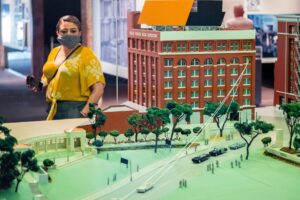November 22, 1963. President John F. Kennedy is assassinated in Dealey Plaza. The Texas School Book Depository building becomes the epicenter of world shock, grief and outrage.
This exhibit, John F. Kennedy and the Memory of a Nation, provides historical context for the events of November 22, 1963, and the aftermath of the assassination. The sixth floor of the Texas School Book Depository was the primary crime scene for the JFK assassination. Visitors will see historic images, news footage, artifacts and original evidentiary areas.

The exhibit’s introductory section outlines the major social movements and political events of the 1960s. Thought-provoking images, artifacts and a short video acclimate you to the period, while presenting insights into JFK, his family and the major issues his administration faced.
THE TRIP TO TEXAS
November 21, 1963. A two-day political trip to five Texas cities gets under way. A short video highlights the enthusiastic crowds cheering on the Kennedy’s throughout their trip and explores the complex social and political atmosphere in Dallas at the time of the assassination.
THE CORNER WINDOW

THE CRISIS HOURS
Forty-five minutes after shots rang out in Dealey Plaza, Dallas Police Officer J.D. Tippit is murdered in the Oak Cliff section of Dallas. Suspect Lee Harvey Oswald, a temporary employee at the Texas School Book Depository, is arrested and charged with both murders. Less than forty-eight hours after the assassination, Oswald is shot in the basement of the Dallas Police Department by local nightclub owner Jack Ruby. Artifacts related to Oswald and Ruby include: Lee Harvey Oswald’s wedding ring, Jack Ruby’s recognizable hat, and the camera used by Dallas Times Herald photographer Bob Jackson to capture the Pulitzer Prize-winning photo of the shooting.

THE INVESTIGATIONS
On September 24, 1964, the Warren Commission’s 889-page report is presented to President Johnson. It concludes that Lee Harvey Oswald assassinated JFK with no evidence of conspiracy. Criticism of this report and lingering questions have prompted decades of research and debate. A short video explores the investigations while visual displays examine the acoustical evidence, photographs, forensic and ballistic tests, and other materials. Featured artifacts include a scale model of Dealey Plaza prepared by the FBI for use by the Warren Commission in 1964, as well as twelve cameras used by eyewitnesses in Dealey Plaza on November 22, 1963.
This space, one of two evidentiary areas on the sixth floor — is recreated from the crime scene photographs taken on November 22, 1963. On display you will see an Italian-made Mannlicher-Carcano rifle identical to the one found in the northwest corner of the sixth floor by investigators.
This exhibit, John F. Kennedy and the Memory of a Nation, provides historical context for the events of November 22, 1963, and the aftermath of the assassination. The sixth floor of the Texas School Book Depository was the primary crime scene for the JFK assassination. Visitors will see historic images, news footage, artifacts and original evidentiary areas.


